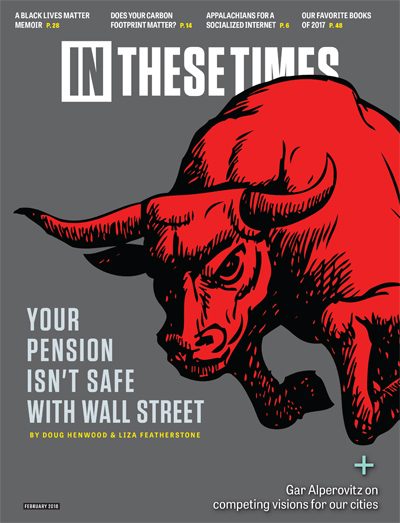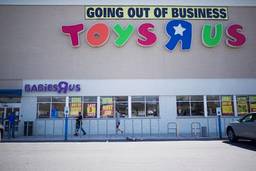Wall Street Isn’t the Answer to the Pension Crisis. Expanding Social Security Is.
The economic fate of workers shouldn’t be tied to a stock market that rewards assaults on the working class.
Doug Henwood and Liza Featherstone

State and local public pension funds across the country are in political and economic crisis. At stake is a comfortable and deserved retirement for millions who have spent their lives serving the public — teaching our children, picking up our garbage, running our libraries. The crisis could also profoundly affect the budgets of state and municipal governments, already weakened by decades of austerity.
The Right decries this parlous situation and demands savage cuts. The unions and their friends say there’s no problem — just reactionaries crying wolf to push an austerity agenda.
But despite the clear bad-faith agenda of the Right — at a recent conference of the Koch brothers’ political network, one speaker joked about their efforts to “bring down the [Alabama] pension system” — the pension problem is real.
Governments have promised trillions of dollars to present and future retirees — $5.9 trillion (according to Federal Reserve statistics) — to be paid out sometime in the future. Unfortunately, they don’t have anywhere near that kind of money, either on hand or in the foreseeable future. Crisis-driven cuts have only made the situation worse. The Fed has calculated that, all told, the nation’s pension accounts are $1.7 trillion in the hole — and others put the shortfall at closer to $4 trillion.
It didn’t have to come to this. During the New Deal, unions advocated for an expansion of Social Security to fund pensions. What they got instead is the current pension fund system, one that is in thrall to both the vagaries of Wall Street and prevarications of politicians. Perhaps, with crisis looming, the time is nigh to consider scrapping the current system and going back to the idea of publicly provided pensions for all — a universal basic retirement income.
Currently, pension funds work similarly to individual retirement accounts. Participants set aside some current income to provide for the future, with interest, dividends and capital gains offering an assist. Governments, too, are supposed to pay in, but for years they have been stinting on contributions. Faced with an unpleasant choice between raising taxes or cutting services to meet a budgetary pinch — or, in some cases, to finance tax cuts — elected officials often decided to skimp on pension pay-ins. For politicians, it’s an easy can to kick down the road, as most won’t be in office when the pension crisis hits. To get the books to balance, public officials assume that markets will essentially boom forever, providing an effortless gusher of cash for retirees. The problem is that the markets may not cooperate, and now that the Baby Boomers are retiring in large numbers, long-deferred bills are coming due.
Worse, the pursuit of unrealistic returns has led union pension managers to invest heavily in hedge funds and private equity, sectors with a viciously anti-worker agenda. This practice forces workers to bet against fellow workers. Longtime labor organizer Stephen Lerner calls this dynamic the labor movement’s “assisted suicide.”
The Grim Math
Pension fund managers have to make several assumptions: how long people will work, how long they will live and how much the financial markets will return over the next few decades. Generally, they assume the future will be more or less like the past. That works for life expectancy, which does not change rapidly, and for retirement age, which follows historical patterns (the fantasy that boomers wouldn’t retire like earlier generations hasn’t panned out). But the stock market, everyone’s favorite source of effortless wealth generation, is a fickle friend.
Yes, over the very long term, stocks return close to 7 percent a year after inflation. But stocks are also very volatile, and 7 percent is far from a guarantee. For example, money invested in 1982 would accrue annually by an average of 7.8 percent over 30 years, compared to only 4.2 percent for money invested in 1964. By the magic of compound interest, the 1982 investment yields almost quadruple the final balance of the 1964 investment (see graph below).
These hypothetical returns are just estimates, of course. You’d have a hard time matching them in the real world, given taxes, commissions and fees. The point is, assuming “average” returns is a very poor guide for someone depending on an investment. This is especially true now, with stock prices having quadrupled since their Great Recession low in March 2009, to some of the highest levels in history relative to underlying corporate profits. Historically, high stock valuations portend crummy future performance.
According to Joshua Rauh, a professor of finance at Stanford, state and local pension systems assume an average annual growth of 7.6 percent. He looked at 694 pension systems — systems that account for more than 97 percent of total state and local pension assets. Rauh also found that the average worker contributing to a pension fund was about 10 years from retirement. If you assume a 7.6 percent return, the nest egg you set aside today would double in those 10 years.
Unfortunately, as Rauh points out, 7.6 percent is far from the most prudent standard for pension accounting. Because Treasury bonds are the safest and most predictable investment available, pegging promises to their interest rates would be the surest way to estimate how much a fund needs to set aside to meet future obligations without a bailout. The 10-year Treasury bond rate is currently about 2.5 percent. At 2.5 percent, an investment will take almost 30 years to double. At that rate, current pension accounts are headed for a shortfall of nearly $4 trillion on the total U.S. pension obligation of $5.9 trillion.
One standard response from the Left might be to dismiss Rauh’s analysis because he is a fellow at the right-wing Hoover Institution, which published his paper. But his math is correct. You could argue that 2.5 percent is too pessimistic a baseline — after all, it could go up. Financial history, however, suggests the 7.6 percent assumption is recklessly optimistic. Yes, the Right wants to make the pension funding situation look dire, but union leaders avoid the consequences of this uncomfortable math either because they are reticent to face up to its implications for their members or because they have become apologists for the giddier assumptions. For example, union-friendly academic Gordon Lafer, in The One Percent Solution: How Corporations are Remaking America One State at a Time, credulously endorses the finance sector’s magical thinking, delighting in the opportunities presented by “volatile but higher-earning equity markets.” He summons a Wall Street investment advisor to offer supporting testimony, and sings the praises of “professional managers,” approvingly gushing that they “make better investment choices” than individual workers, basing their decisions on “long-term horizons.”
The problem isn’t just one of math, however. It’s also unclear how allying with financiers will advance the interests of working people.
Squeezing Workers For Interest
In search of higher returns, pension fund managers have taken to what are known in the trade as “alternative investments,” such as hedge funds and private equity.
Although distinctions can blur, hedge funds are aggressively managed — run by professionals intent on making boatloads of money quickly, which means they can also lose boatloads of money suddenly. They trade in what is known in economics as “hot money” — highly speculative, short-term capital investments that create massive market instability by moving money fast. That instability has greatly increased the precarity of the working class, fueling, for example, the housing bubble that led so many to lose their homes to foreclosure.
Private equity (PE) generally has a longer time horizon, with fund managers investing in a business for several years. Their aim is to increase a company’s profitability by increasing its “efficiency,” then sell their stake at a profit. In the interim, PE funds often take cash out of the business through dividends and fees. PE can be a very lucrative line of work, and managers enjoy special tax breaks on top of their big paychecks.
So-called efficiency is often code for “screwing workers.” An infamous example is what happened at Safeway stores in the 1980s. By mid-decade, the unionized supermarket chain was suffering increased competition from lower-cost nonunion stores. In 1986, the company went private in a leveraged buyout engineered by boutique investment house Kohlberg Kravis Roberts (KKR). In a leveraged buyout, a small group of investors (in partnership with corporate management), borrows lots of money to buy out a business. That debt is often quite burdensome, which is part of the point: The urgency of the debt becomes a disciplinary force, driving management to achieve greater “efficiencies.” In the case of Safeway, that meant selling off divisions (mostly to nonunion operators), closing stores and squeezing labor. In all, 63,000 people lost their jobs. The human toll was detailed by Susan Faludi in a 1990 article for the Wall Street Journal: suicide, alcoholism, heart attacks, bankruptcy and broken lives. Displaced workers had a hard time finding new jobs, and those who did saw their pay cut by, on average, more than half. But KKR made off with $7.2 billion, after an initial investment of $129 million.







